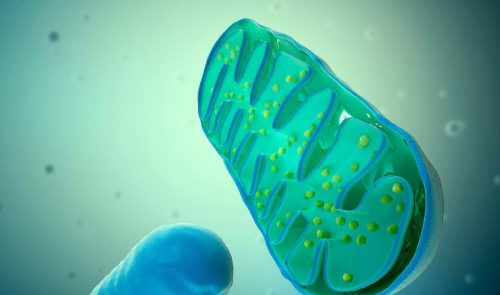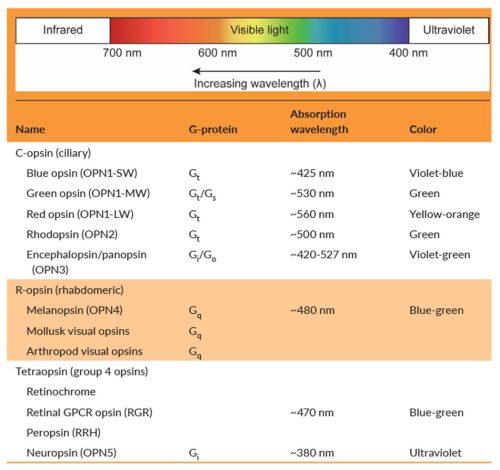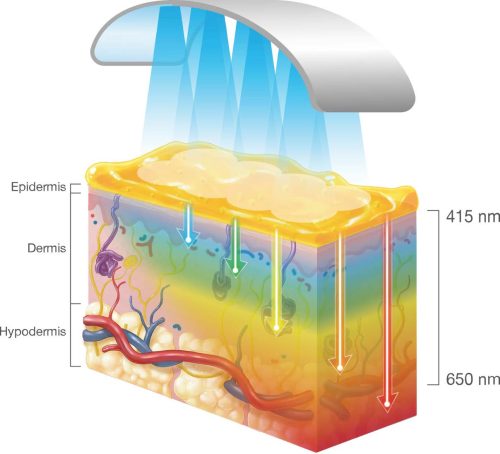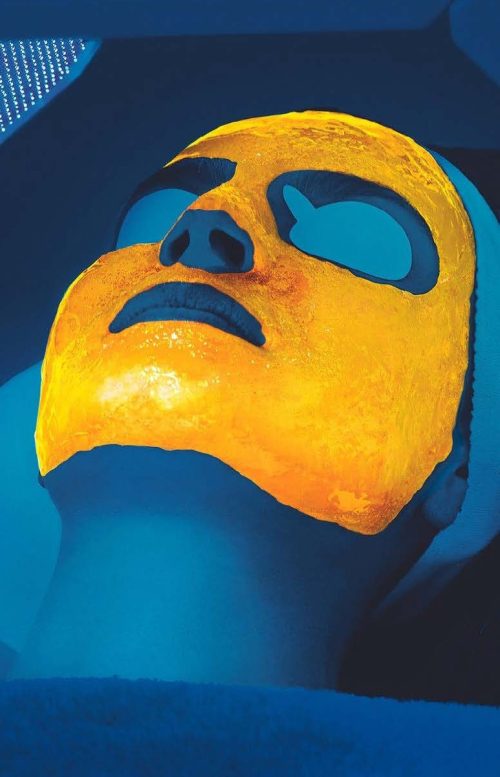
Light stimuli exert an influence on biological cells
Light stimuli produce photophysical and photochemical reactions in the skin.
Key target: Mitochondria
Present in almost every cell, their primary function is to generate energy to allow the cell to operate optimally.
Mitochondria present in skin cells convert light into energy, which is used to activate specific genes apt to regulate how quickly cells are renewed, repaired and grow.
FLE TECH induces biological responses in the mitochondria, ultimately supplying energy and improving cell function.

CELLS RESPOND TO LIGHT
FLE USES EVOLUTIONARY MECHANISMS BY ACTIVATING ENDOGENOUS CELLULAR MOLECULES.
Many chromophores respond to different wavelengths (colours) of light, inducing specific effects.
The activation of endogenous chromophores (e.g., cytochrome c oxidase, TRPV1 channels, opsins, flavoproteins) is responsible for many of the therapeutic effects of FLE:
• increases the production of cellular energy (ATP);
• modulates inflammation;
• increases collagen synthesis;
• promotes cell proliferation and activation.
Hamblin MR. Mechanisms and Mitochondrial Redox Signaling in Photobiomodulation. Photochem Photobiol. 2018;94(2):199-212. doi:10.1111/php.12864.
Huang, YY, et al. Biphasis dose response in low level light therapy -an update. Dose Response. 2011; 9(4):602-18

OPSINS (OPN)
Endogenous chromophores present throughout the target tissue(epidermis, dermis and hypodermis).
Light acts as a drug on these receptors, stimulating secondary cellular reactions.

Suh, S., Choi, E. H., & Mesinkovska, N. A. (2020). The expression of opsins in the human skin and its implications for photobiomodulation: A Systematic Review. Photodermatology, photoimmunology & photomedicine, 36(5), 329.

WHAT IS SO SPECIAL ABOUT OUR LIGHT?
THE GEL

What is it?
EXCITATION OF THE CHROMOPHORE IS NOT JUST A SHIFT IN WAVELENGTHS

CREATION OF FLE

LIGHT PENETRATION OF THE SKIN
Endogenous chromophores present throughout the target tissue (epidermis, dermis and hypodermis).
Light acts as a drug on these receptors, stimulating secondary cellular reactions.
Edge, D. Et al. Fluorescent Light Energy: the future for treating inflammatory skin conditions? J Clin Aesthet Dermatol. 2019;12(5):E61–E68
Jalili, A. 2018. Chromophore gel-assisted phototherapy. A novel and promising photobiomodulation therapy for facial inflammatory skin diseases and skin aging. J Ästhet Chir. 2018

Effect of FLE compared to continuous LED light
Effect of FLE compared to continuous LED light on collagen production from primary human dermal fibroblast (HDF) in both, presence and absence of the pro-inflammatory cytokine interferon gamma (IFN-γ), which simulates stressed HDF cells.
To test this, three sets of cells were prepared and exposed to:
1) Non-illuminated control
2) Mimicking lamp and
3) Exposed to FLE.
The mimicking lamp had an identical spectral output to FLE TECH, but was generated by continuous LED light instead of excited chromophore emissions combined with blue LED light, i.e. no fluorescence created.
» Collagen production in fibroblasts treated with FLE was significantly increased compared to non-illuminated control cells and cells treated with the mimicking lamp.
» FLE enhanced the collagen production from non-stressed HDF cells (absence of IFN-γ), explaining why we do not see collagen production in stressed and inflamed skin.
For non-stressed HDF cells collagen, production was significantly increased for FLE compared to non-illuminated control cells and those treated with the mimicking lamp.

Edge, D. et al. Fluorescent Light Energy: the future for treating inflammatory skin conditions? J Clin Aesthet Dermatol (2019);12(5):E61–E68.

A blue LED will activate FLE TECH, our PATENTED photoconverter gel containing exogenous chromophores.
These molecules, thanks to the physical property of Fluorescence, are able to generate: a dynamic hyperpulsed spectrum containing all the wavelengths in a range from 500 to 650 nm.
Working simultaneously on both epidermal and dermal layers.

FLE TECH
ALL WAVELENGTHS
IN A SINGLE TREATMENT





FLE simultaneously covers the entire spectrum from green to red (500-650 nm)
Edge, D., Schødt, M., Nielsen, M.C.E. (2020). Biophotonic Therapy Induced Photobiomodulation. In: Fimiani, M., Rubegni, P., Cinotti, E. (eds) Technology in Practical Dermatology. Springer
BENEFITS
- Stimulation of cellular activity and normalisation of skin functions.
- Stimulation of healing and repair mechanisms.
- Anti-inflammatory effect.
- Stimulation of microcirculation.
- Stimulation of collagen production.
ADVANTAGES
- Non-destructive.
- Non-systemic.
- Non-photosensitising, can be used even in summer.
- Painless.
- Little to no downtime.
- Quick treatment session time.
- Can be combined with other treatments.
FLE TECH



FLE TECH: INNOVATIVE TECHNOLOGY BORN FROM TISSUE REGENERATION & WOUND CARE
CLINICAL EVIDENCE
FLE TECH: LumiHeal®’s safety and efficacy has been demonstrated in a multi-center, real-life trial of 99 wounds, most of them being previously non-responsive, hard-to-heal patients with chronic wounds (VLUs, DFUs, PUs).

FLE TECH: INNOVATIVE TECHNOLOGY BORN FROM WOUND CARE

+ 30 clinical studies
STRONGSCIENTIFIC EVIDENCE.
FLE TECH is supported by strong scientific evidence, multiple clinical studies and a CE mark in Europe for a variety of wound types including chronic wounds, dermatology: Acne, Rosacea and Skin Rejuvenation.
REPAIR & REGENERATE SKIN AT A CELLULAR LEVEL
- Activates mitochondria
Mitochondrial network restoration increases the production of adenosine triphosphate(ATP).
Reactive oxygen species (ROS) modulation reduces inflammation, improves cellular proliferation and oxygenation.
• Anti-inflammatory effects
Lowered secretion of pro-inflammatory cytokines (IL-6 and TNF-α).
• Skin remodeling
FLE stimulates the cell replication, all the epidermal layers result active and well organized.
• Stimulation of fibroblasts
Enhanced production and arrangement of collagen impact the overall skin matrix and the reflection of light with a ‘glow’ effect. FLE induces a 400% increase in collagen production.
• Improves microvascularization
The production of specific growth factors such as Vascular Endothelial Growth Factor (VEGF) and angiogenesis are increased.
Edge, D., Schødt, M., Nielsen, M.C.E. (2020). Biophotonic Therapy Induced Photobiomodulation. In: Fimiani, M., Rubegni, P., Cinotti, E. (eds) Technology in Practical Dermatology. Springer
TREATMENT AREAS
Face, neck, décolleté, hands.

3 Steps

Safe
Painless
Non -invasive
Non -photosensitising
It can be used all year round
PATENTED TECHNOLOGY
FLUOROPHORE EXCITEMENT
In order to produce FLE, fluorophores should be excited with a blue LED lamp with the following characteristics:

In order to produce FLE, fluorophores should be excited with a blue LED lamp with the following characteristics:
Lumixa:
For use with allBlue LED professional.
• Wavelengths: from 415 to 470 nm
• Fluence: 15 -25 J/cm²
• between 10 and 15 minutes
EX: Modula FLE, Dermalux, Omnilux, Celluma, Triwings, Lutronic, Deleo, Medika, GME, CryomedLPL, NEOLEDTECH.
In order to produce FLE, fluorophores should be excited with a blue LED lamp with the following characteristics:

Kleresca:
• Wavelengths: from 440 to 460 nm
• Fluence: ≈ 30 -39 J/cm²
• 9 minutes
Modula FLE
Preset programmes:
KLERESCA ACNE TREATMENT
KLERESCA ROSACEA TREATMENT
REJUVENATION
Adapotable parametres:
Wavelength(415 nm and/or 447 nm)
Duration (up to 20 minutes)
Intensity(up to 50 mW)
APPLICATION PROTOCOL


FLE TECH Treatments
“Lumixa”
AESTHETIC MEDICINE
cosmetic treatment
• Lumixa Skin Normaliser
• Lumixa Collagen Booster
“Kleresca”
DERMATOLOGIST
medical device class IIa
• Kleresca Acne Treatment
• Kleresca Rosacea Treatment
• Kleresca Skin Rejuvenation (cosmetic treatment)
“LumiHeal”
WOUND HEALING
medical device class IIb
Acute & chronic wounds

